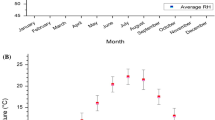Abstract
The article presents the literature review on building environment quality especially humidity of historical buildings. It is based on the research of the application of electro osmosis for drying of historical buildings in Bratislava conducted by the Department of the physics at the Faculty of Civil Engineering Slovak University of Technology in Bratislava. The applied technology is put in the context with the Smart Cities concept, to extend and improve the efficiency of the dehumidification process.




Similar content being viewed by others
References
Vitruvius P, Morgan MH (1960) Vitruvius: the ten books on architecture. Dover Publications, New York
Pavlendová G (2015) The effective usage of electro osmosis in civil engineering. Habilitation thesis. Slovak University of Technology, Faculty of Civil Engineering.165 pp
Smith BM (1986) Moisture Problems in Historic Masonry Walls: Diagnosis and Treatment [online]. Washington : U.S. Dept. of the Interior, National Park Service. (Accessed 1 May 2019). Available from: https://archive.org/stream/moistureproblems00unse#page/15/mode/1up
Bertoliny L, Coppola L, Gastaldi M, Redaelli E (2009) Electro osmotic transport in porous construction materials and dehumidification of masonry. Constr Build Mater 23(1):254–263. https://doi.org/10.1016/j.conbuildmat.2007.12.013 Available from: http://www.sciencedirect.com/science/article/pii/S095006180800007X. (Accessed 28 April 2019)
Balík L (2004) Využití elektroosmózy k dodatečnému vysušovaní zdí [online]. České vysoké učení technické v Praze Fakulta stavební, Praha (Accessed 28 April 2019). Available from: http://web.cvut.cz/ki/710/phd/balik.pdf
Rörig-Dalgaard I, Ottosen LM, Christensen IV (2008) Desalination of a wall section with murals by electromigration. In: Proceedings of the international conference of salt weathering on buildings and stone sculptures. Copenhagen, Oct 22–24 2008, pp 361–371
Little DA, Von Fay, Kurt F (2013) Electro-Osmotic Pulse Leak Repair Method: Evaluation in Trinity Dam Bonnet Chamber - Central Valley Project, Trinity River Division – California [online]. California. Available from: http://www.google.sk/url?sa=t&rct=j&q=&esrc=s&source=web&cd=1&ved=0CC0QFjAA&url=http://www.usbr.gov/research/projects/download_product.cfm?id=734&ei=QCQbU__HAYnesga12YCwAg&usg=AFQjCNGjmIfYxnreimh-2c6JKkRcDiV3vA&sig2=ZwGGelsrunMYJtQ_p-pbVg&bvm=bv.62578216,d.Yms
Marshall OS, Morefield S, McInerney MK, Hock VF, Femmer PD (2011) Electro-osmotic pulse (EOP) treatment method. United states patent US007935236B2 [online]. Available from: http://www.google.sk/url?sa=t&rct=j&q=&esrc=s&source=web&cd=1&ved=0CCcQFjAA&url=http://patentimages.storage.googleapis.com/pdfs/US7935236.pdf&ei=VccZU_vXKsuS7AaZl4HAAQ&usg=AFQjCNFduokBHqDavJkO-9u9TEJ6DOj37w&bvm=bv.62578216,d.ZGU
Morefield S, Hock V, McInerney MK, Marshall OS, Marsh ChP, Cooper S (2003)Control of water migration through concrete using electro-osmosis. Tri-Service Corrosion Conference [online] 2003. (Accessed 25 April 2019). Available from: https://www.nace.org/cstm/Store/Product.aspx?id=1b2494b6-49c2-436f-813c-eb4b634b493a
Klečka T (2005) Magnetokinetické metody sanace vlhkosti. TZBinfo [online] 2005. Available from: http://www.tzb-info.cz/2894-magnetokineticke-metody-sanace-vlhkosti
Kolář J (2012) PRINS – insulation and stabilisation of masonry in historical buildings. Incheba Praha [online]. 2012. (Accessed 1 May 2014). Available from: http://www.incheba.cz/en/veletrh/monuments/news-archive/news.html/456_4978-ing.-josef-kolar%2D%2Dprins-insulation-and-stabilisation-of-masonry-in-historical-buildings
Kolář J (2012) PRINS – insulation and stabilisation of masonry in historical buildings. Incheba Praha [online] 2012. (Accessed 1 May 2019). Available from: http://www.incheba.cz/en/veletrh/monuments/news-archive/news.html/456_4978-ing.-josef-kolar%2D%2Dprins-insulation-and-stabilisation-of-masonry-in-historical-buildings
Morarau DS (1974) Methods and electrodes for the drying of damp buildings [online]. United States patent. US3856646 A. 24 December 1974. United States. (Accessed 1 March 2019). Available from: http://www.google.com/patents/US3856646
Utklev K (1994) Method and apparatus for controlling the relative humidity in concrete and masonry structures [online]. United States patent US5368709 A. (Accessed. 16. May 2019). 29. November 1994. Available from: https://www.google.com/patents/US5368709?dq=%22US5368709%22&hl=en&sa=X&ei=lKnGU5qUH6fH0QW9x4CIBw&ved=0CB4Q6AEwAA
Kristiansen H (1998) Method for dehydrating capillary materials [online]. United States patent US5755945 A. (Accessed. 16. May 2019). 26. May 1998. Available from: https://www.google.com/patents/US5755945?dq=%22US5755945%22&hl=en&sa=X&ei=qqrGU-isE8fZ0QXM24CQBQ&ved=0CB4Q6AEwAA
Bjerke E, Olson H (2000) Dehydrating porous materials, such as moist walls and/or floors of a masonry or concrete structure, as well as the clay containment structure of a landfill, through the use of electro-osmosis [online]. United States patent US6117295 a. [accessed. 16. May 2019]. 12. September 2000. Available from: https://www.google.com/patents/US6117295?dq=%22US6117295%22&hl=en&sa=X&ei=zKvGU5r3IceX1AWShoDgAg&ved=0CB4Q6AEwAA
Schlegel R (2002) Wall moisture electro-osmotic removal assembly has electrically-conducting plastic electrodes [online]. Germen patent DE10058507 A1. 6 June 2002. Google Patents. Available from: http://www.google.com/patents/DE10058507A1?cl=en
Lectros system. (2019) (Accessed 16 May 2019). Available from: https://wykamol.com/products/damp-proofing
Aquastop. (2019). [accessed. 16. May 2019]. Available from: https://www.aquastop.ie/
Steininger K-H (1994) Electrode [online]. EP0333700 B1. (Accessed 16 July 2014). 2. November 1994. Available from: https://www.google.com/patents/EP0333700B1?cl=en&dq=%22EP+0333700+B1+%22&hl=en&sa=X&ei=9q3GU7y7D-fZ0QXB94DACw&ved=0CBwQ6AEwAA
Kerasan (2019) (Accessed 16 May 2019). Available from: http://www.kerasan.at/
Hydrobeton, SRO (2019) Available from: http:www.hydrobeton.sk
SHMU. Available from: http://www.shmu.sk/sk/?page=1
Smart Cities Council. (2019) (Accessed 16 May 2019). Available from: https://smartcitiescouncil.com/
US Office Technical and Scientific Information. (2019) (Accessed 16 May 2019). Available from: https://www.osti.gov/
Guerrero-Pérez AD, Huerta A, González F, López D (2013) Network architecture based on virtualized networks for smart cities. IEEE White Papers on Smart Cities. [online]. (Accessed 16 May 2019). Available from: https://smartcities.ieee.org/images/files/pdf/ngn_sdn_v3.1.0.pdf
Deshpande Ch (2016) What are the 4 layers of data “architecture” needed for smart cities? [online]. (Accessed 16 May 2019). Available from: https://readwrite.com/2016/12/19/architecture-smart-cities-cl1/
Acknowledgments
The paper is part of the APVV project No. 15-0681 and VEGA project No. 1/0101/18.
Author information
Authors and Affiliations
Corresponding author
Additional information
Publisher’s note
Springer Nature remains neutral with regard to jurisdictional claims in published maps and institutional affiliations.
Rights and permissions
About this article
Cite this article
Pavlendová, G., Šujanová, J., Cagáňová, D. et al. Smart Cities Concept for Historical Buildings. Mobile Netw Appl 25, 876–881 (2020). https://doi.org/10.1007/s11036-020-01521-7
Published:
Issue Date:
DOI: https://doi.org/10.1007/s11036-020-01521-7




